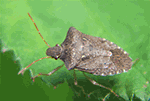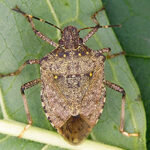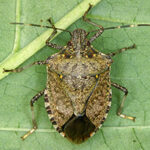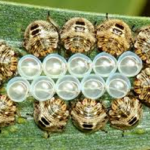 Stink bugs feel like nature’s revenge for every insect you’ve ever squished. They get their name from the foul stench they release when they’re threatened or disturbed. It’s a smell that’s tough to describe. Chemically it contains compounds found in cilantro, but the odor is stronger, with notes of dirty socks, rotting fruit and paper-mill pulp. In short, it stinks and worse, it lingers.
Stink bugs feel like nature’s revenge for every insect you’ve ever squished. They get their name from the foul stench they release when they’re threatened or disturbed. It’s a smell that’s tough to describe. Chemically it contains compounds found in cilantro, but the odor is stronger, with notes of dirty socks, rotting fruit and paper-mill pulp. In short, it stinks and worse, it lingers.
Why Stink Bugs Come Indoors
 Seasonal cues trigger stink bugs’ search for winter quarters; the shortening days and falling temperatures sending them scuttling for cover. If they sheltered beneath tree bark or mulch, it would be one thing. But they prefer sharing your home over winter, piling into cracks and crevices by the thousands.
Seasonal cues trigger stink bugs’ search for winter quarters; the shortening days and falling temperatures sending them scuttling for cover. If they sheltered beneath tree bark or mulch, it would be one thing. But they prefer sharing your home over winter, piling into cracks and crevices by the thousands.
Stink Bug Origins
Stink bugs are said to have arrived on our shores in the Nineties  after hitching a ride in shipping containers from China and have now made themselves right at home. Though they are a major crop pest, they don’t bite, sting or pose a health risk, brown marmorated stink bugs named for the brown marbled pattern on their backs, are an annoyance (especially if you smash them and release the eponymous smell that keeps predators away), and a sure way to put a damper on your nesting since bugs that enter the home when the weather turns cool tend to stay put in walls or attics until spring.
after hitching a ride in shipping containers from China and have now made themselves right at home. Though they are a major crop pest, they don’t bite, sting or pose a health risk, brown marmorated stink bugs named for the brown marbled pattern on their backs, are an annoyance (especially if you smash them and release the eponymous smell that keeps predators away), and a sure way to put a damper on your nesting since bugs that enter the home when the weather turns cool tend to stay put in walls or attics until spring.
Stink Bugs Indoors
Once stink bugs hide indoors, they stage a slow-motion home invasion all winter long. They’re intrepid explorers, lumbering along any surface countertop, couch, toaster, or bed. They like warm places, which means they’re happy to jump into your shower or morning coffee. When they fly, they bump and blunder into things, sounding like helicopters with serious mechanical issues.
The reason for a stink bug’s disoriented behavior indoors is diapause, a sort of insect hibernation. This zombie-like state allows them to move, just not with much finesse. They typically appear when a winter warm spell fools them into thinking it’s spring. Instead of finding their way outdoors, they emerge in your living spaces and chaos ensues.
The good news is that they don’t eat, bite, or reproduce indoors. When spring arrives, they’ll head outside to kick off a new season of munching and mating. The bad news is that if you spot a few, there’s likely an army waiting to march into view, one at a time.
How To Deal With Stink Bugs
Inside, stink bugs tend to congregate on upper floors and in tight spaces. That’s why they often tuck into drapery folds and walk along the tops of walls. It’s why they mass in attics and crawl spaces above garages. So, what do you do when you spot a stink bug on the move inside?
Safeguard Your House
Prevention is key in combatting these critters. Caulk all cracks and crevices where bugs can enter. Place fine mesh over air vents to keep bugs from trying that sneaky alternative entryway.
Avoid Chemical Insecticides
It’s tempting to douse the stinkers with an all-purpose insecticide, but few actually work to kill these bugs (they often raise from the dead a few days later). Also, if you do manage to kill them, their bodies may attract other insects to feed on them.
How To Keep Stink Bugs out
The best approach is to prevent them from coming in by sealing cracks around windows, doors, and roof soffits. Stink bugs typically gather on warm, west-facing walls and enter buildings via cracks and crevices. Once they find an ideal spot, they release pheromones, chemical signals that beckon more stink bugs to join the party. Your best bet is to keep them out in the first place. Here are some tips and tricks.
- Block points of entry. Use caulking to replace cracked seals around utility entry points, doors, and windows. Inspect joints where two different materials meet, like wood and concrete block or wood siding and brick. Caulk the cracks as needed.
- Check doors. Look over weather stripping and sweeps on doors, including the rubber seal on garage doors. Replace as needed.
- Inspect screens. Check for holes and patch as needed. Make sure the screens fit tightly into their space. Rub screens with dryer sheets some homeowners say it works to keep the bugs from blanketing screens.
- Squish some. Some homeowners report that if they squish a few stink bugs where they start to gather, it seems to repel other ones. Some folks even whip up a stink bug spray (stink bugs and water in a blender, strain out any solids) that, when sprayed on a home, seems to help deter the bugs.
It’s important to understand however, that Stink bugs can quickly turn into an infestation if no action is taken.
If you experience an influx of Stink bugs in or around your home, call the experts at Universal Pest Services (610)449-0740 and schedule a free inspection today!